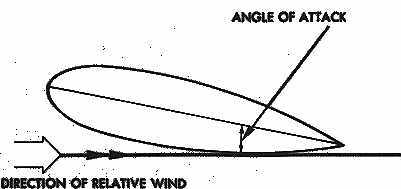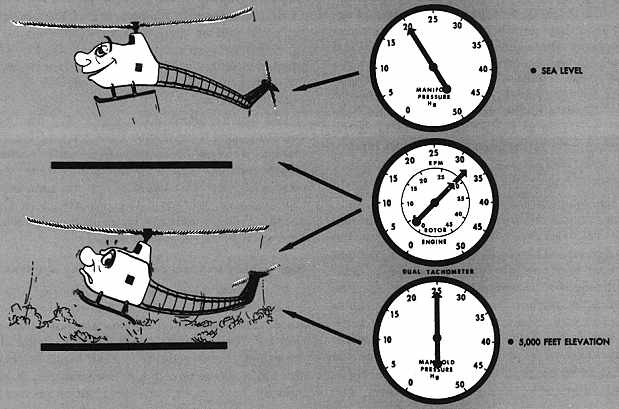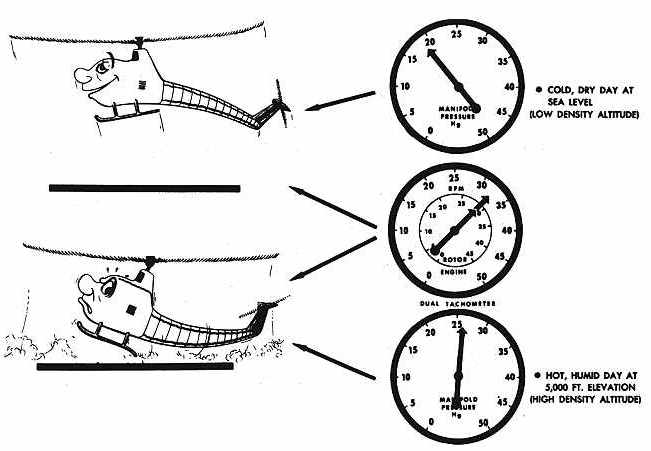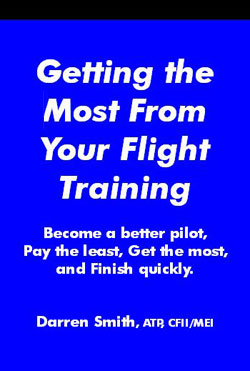
 |
||
| Home | Login | Schedule | Pilot Store | 7-Day IFR | IFR Adventure | Trip Reports | Blog | Fun | Reviews | Weather | Articles | Links | Helicopter | Download | Bio | ||
Site MapSubscribePrivate Pilot Learn to Fly Instrument Pilot 7 day IFR Rating IFR Adventure Commercial Pilot Multi-Engine Pilot Human Factors/CRM Recurrent Training Ground Schools Articles Privacy Policy About Me Keyword:  |
Chapter 1. GENERAL AERODYNAMICS (continued)  Angle of attack - The angle of attack is the angle between the chord line of the airfoil and the direction of the relative wind (figure 5). The angle of attack should not be confused with the pitch angle of the rotor blades. The pitch angle is determined by the position of the appropriate cockpit controls (collective and cyclic pitch), whereas the angle of attack is determined by the direction of the relative wind. The angle of attack may be less than, equal to, or greater than the pitch angle as shown in figure 6. The pilot can increase or decrease the angle of attack by changing the pitch angle of the rotor blades. If the pitch angle is increased, the angle of attack is increased; if the pitch angle is decreased, the angle of attack is decreased. Since the angle of attack is dependent on the relative wind, the same factors that affect the relative wind also affect the angle of attack.  Lift - The force, lift, is derived from an airfoil
through a principle
often referred to as Bernoulli's Principle or the "venturi effect." As
air velocity increases through the constricted portion of a venturi
tube, the pressure decreases. Compare the upper surface of an airfoil
with the constriction in the venturi tube (figure 7). They are very
similar. The upper half of the venturi tube is replaced by layers of
undisturbed air. Thus, as air flows over the upper surface of an
airfoil, the curvature of the airfoil causes an increase in the speed
of the airflow. The increased speed of airflow results in a decrease in
pressure on the upper surface of the airfoil. At the same time, airflow
strikes the lower surface of the airfoil at an angle, building up
pressure. The combination of decreased pressure on the upper surface
and increased pressure on the lower surface results in an upward force.
This is the force, lift. Figure 6 - The relationship between the
angle of attack and pitch angle
for various positions of the rotor blade in the plane of rotation
during forward flight. Angle of attack is less than pitch angle 90°
to
pilot's right (top); greater than pitch angle 90° to pilot's left
(bottom); and equal to pitch angle in the fore (left) and aft (right)
positions. Lift - The force, lift, is derived from an airfoil
through a principle
often referred to as Bernoulli's Principle or the "venturi effect." As
air velocity increases through the constricted portion of a venturi
tube, the pressure decreases. Compare the upper surface of an airfoil
with the constriction in the venturi tube (figure 7). They are very
similar. The upper half of the venturi tube is replaced by layers of
undisturbed air. Thus, as air flows over the upper surface of an
airfoil, the curvature of the airfoil causes an increase in the speed
of the airflow. The increased speed of airflow results in a decrease in
pressure on the upper surface of the airfoil. At the same time, airflow
strikes the lower surface of the airfoil at an angle, building up
pressure. The combination of decreased pressure on the upper surface
and increased pressure on the lower surface results in an upward force.
This is the force, lift. Figure 6 - The relationship between the
angle of attack and pitch angle
for various positions of the rotor blade in the plane of rotation
during forward flight. Angle of attack is less than pitch angle 90°
to
pilot's right (top); greater than pitch angle 90° to pilot's left
(bottom); and equal to pitch angle in the fore (left) and aft (right)
positions.  Figure 7 - (Top half) Bernoulli's Principle: Increased air velocity produces decreased pressure; (Bottom half) Lift is produced by an airfoil through a combination of decreased pressure above the airfoil (as per Bernoulli's Principle), and increased pressure beneath. Drag (airfoil) - At the same time the airfoil is producing lift, it also is subject to a drag form. Drag is the term used for the force that tends to resist movement of the airfoil through the air - the retarding force of inertia and wind resistance. Drag acts parallel and in the opposite direction to the movement of the airfoil or, if you prefer, in the same direction as the relative wind. This force, drag, causes a reduction in rotor RPM (revolutions per minute) when the angle of attack is increased. An increase in angle of attack then not only produces an increase, in lift, but it also produces an increase in drag (figure 8). Figure 8 - Relationship between angle of attack and lift and drag forces. As the angle of attack increases, lift and drag increase. Stall - When the angle of attack increases up to a certain point, the air can no longer flow smoothly over the top surface because of the excessive change of direction required. This loss of streamlined flow results in a swirling, turbulent airflow, and a large increase in drag. The turbulent airflow also causes a sudden increase in pressure on the top surface resulting in a large loss of lift. At this point, the airfoil is said to be in a stalled condition.  Lift and angle of attack - As the angle of attack of an
airfoil
increases, the lift increases (up to the stall angle) providing the
velocity of the airflow (relative wind) remains the same (figure 8).
Since the pilot can increase or decrease the angle of attack by
increasing or decreasing the pitch angle of the rotor blades through
the use of the collective pitch cockpit control, lift produced by the
rotor blades can be increased or decreased. The pilot must remember,
however, that any increase in angle of attack will also increase drag
on the rotor blades, tending to slow down the rotor rotation.
Additional power will be required to prevent this slowing down of the
rotor. Lift and angle of attack - As the angle of attack of an
airfoil
increases, the lift increases (up to the stall angle) providing the
velocity of the airflow (relative wind) remains the same (figure 8).
Since the pilot can increase or decrease the angle of attack by
increasing or decreasing the pitch angle of the rotor blades through
the use of the collective pitch cockpit control, lift produced by the
rotor blades can be increased or decreased. The pilot must remember,
however, that any increase in angle of attack will also increase drag
on the rotor blades, tending to slow down the rotor rotation.
Additional power will be required to prevent this slowing down of the
rotor. Lift and velocity of airflow - As the velocity of the airflow (relative wind) increases, the lift increases for any given angle of attack. Since the pilot can increase or decrease the rotor RPM which, in turn, increases or decreases the velocity of the airflow, the amount of lift can be changed. As a general rule, however, the pilot attempts to maintain a constant rotor RPM and changes the lift force by varying the angle of attack. Lift and air density - Lift varies directly with the density of the air - as the air density increases, lift and drag increase; as air density decreases, lift and drag decrease.  What affects air density? Altitude and atmospheric
changes affect air
density. The higher the altitude the less dense the air. At 10,000 feet
the air is only two-thirds as dense as the air at sea level. Therefore,
if a helicopter is to maintain its lift, the angle of attack of the
rotor blades must be increased. To increase the angle of attack, the
pilot must increase the pitch angle of the blades. We have already seen
that, as the pitch angle increases, drag on the rotor system increases
and the rotor RPM tends to decrease. Therefore, more power must be
applied to prevent a decrease in rotor RPM. This is why a helicopter
requires more power to hover at higher altitudes than under the same
conditions at lower altitudes. (See figure 52 to the right) What affects air density? Altitude and atmospheric
changes affect air
density. The higher the altitude the less dense the air. At 10,000 feet
the air is only two-thirds as dense as the air at sea level. Therefore,
if a helicopter is to maintain its lift, the angle of attack of the
rotor blades must be increased. To increase the angle of attack, the
pilot must increase the pitch angle of the blades. We have already seen
that, as the pitch angle increases, drag on the rotor system increases
and the rotor RPM tends to decrease. Therefore, more power must be
applied to prevent a decrease in rotor RPM. This is why a helicopter
requires more power to hover at higher altitudes than under the same
conditions at lower altitudes. (See figure 52 to the right)  Due to the atmospheric changes in temperature, pressure,
or humidity,
the density of the air may be different, even at the same altitude,
from one day to the next or from one location in the country to
another. Because air expands when heated, hot air is less dense than
cold air. For the helicopter to produce the same amount of lift on a
hot day as on a cold day, the rotor blades must be operated at a higher
angle of attack. This requires that the blades be operated at a greater
pitch angle which increases rotor drag and trends to reduce rotor RPM.
Therefore, to maintain a constant rotor RPM, more throttle is required.
For this reason, a helicopter requires more power to hover on a hot day
than on a cold day. (See figure 53 to the right) Due to the atmospheric changes in temperature, pressure,
or humidity,
the density of the air may be different, even at the same altitude,
from one day to the next or from one location in the country to
another. Because air expands when heated, hot air is less dense than
cold air. For the helicopter to produce the same amount of lift on a
hot day as on a cold day, the rotor blades must be operated at a higher
angle of attack. This requires that the blades be operated at a greater
pitch angle which increases rotor drag and trends to reduce rotor RPM.
Therefore, to maintain a constant rotor RPM, more throttle is required.
For this reason, a helicopter requires more power to hover on a hot day
than on a cold day. (See figure 53 to the right) Since air expands as pressure is decreased, there will be fluctuations in the air density due to changes in atmospheric pressure. The lower the pressure, the less dense the air and, for the same reason stated previously, the greater the power required to hover.  Because water vapor weighs less than an equal amount of
dry air, moist
air (high relative humidity) is less dense than dry air (low relative
humidity). Because of this, a helicopter will require more power to
hover on a humid day than on a dry day (see figure 54 to the right).
This is especially true on hot, humid days
because the hotter the day, the greater the amount of water vapor the
air can hold. The more moisture (water vapor) in the air, the less
dense the air. Because water vapor weighs less than an equal amount of
dry air, moist
air (high relative humidity) is less dense than dry air (low relative
humidity). Because of this, a helicopter will require more power to
hover on a humid day than on a dry day (see figure 54 to the right).
This is especially true on hot, humid days
because the hotter the day, the greater the amount of water vapor the
air can hold. The more moisture (water vapor) in the air, the less
dense the air. From the above discussion, it is obvious that a pilot should beware of high, hot, and humid conditions - high altitudes, hot temperatures, and high moisture content (see figure 55 below). A pilot should be especially aware of these conditions at the destination, since sufficient power may not be available to complete a landing safely, particularly when the helicopter is operating at high gross weights (see figure 64 below).  Lift and weight - The total weight (gross weight) of a helicopter is the first force that must be overcome before flight is possible. Lift, the force which overcomes or balances the force of weight, is obtained from the rotation of the main rotor blades. Thrust and drag - Thrust moves the aircraft in the desired direction; drag, the retarding force of inertia and wind resistance, tends to hold it back. In vertical flight, drag acts downward; in horizontal flight, drag acts horizontally and opposite in direction to the thrust component. Thrust, like lift, is obtained from the main rotor. Drag, as discussed here, is the drag of the entire helicopter - not just the drag of the rotor blades which was discussed earlier. The use of the term "drag" in subsequent portions of this handbook should be considered as having this same connotation. In future references to the drag of the rotor blades, the statement "drag of the rotor blades or rotor system" will be used. Figure 64 below. 
Your Thoughts... |

|
| Home | Login | Schedule | Pilot Store | 7-Day IFR | IFR Adventure | Trip Reports | Blog | Fun | Reviews | Weather | Articles | Links | Helicopter | Download | Bio |
| All content is Copyright 2002-2010 by Darren Smith. All rights reserved. Subject to change without notice. This website is not a substitute for competent flight instruction. There are no representations or warranties of any kind made pertaining to this service/information and any warranty, express or implied, is excluded and disclaimed including but not limited to the implied warranties of merchantability and/or fitness for a particular purpose. Under no circumstances or theories of liability, including without limitation the negligence of any party, contract, warranty or strict liability in tort, shall the website creator/author or any of its affiliated or related organizations be liable for any direct, indirect, incidental, special, consequential or punitive damages as a result of the use of, or the inability to use, any information provided through this service even if advised of the possibility of such damages. For more information about this website, including the privacy policy, see about this website. |